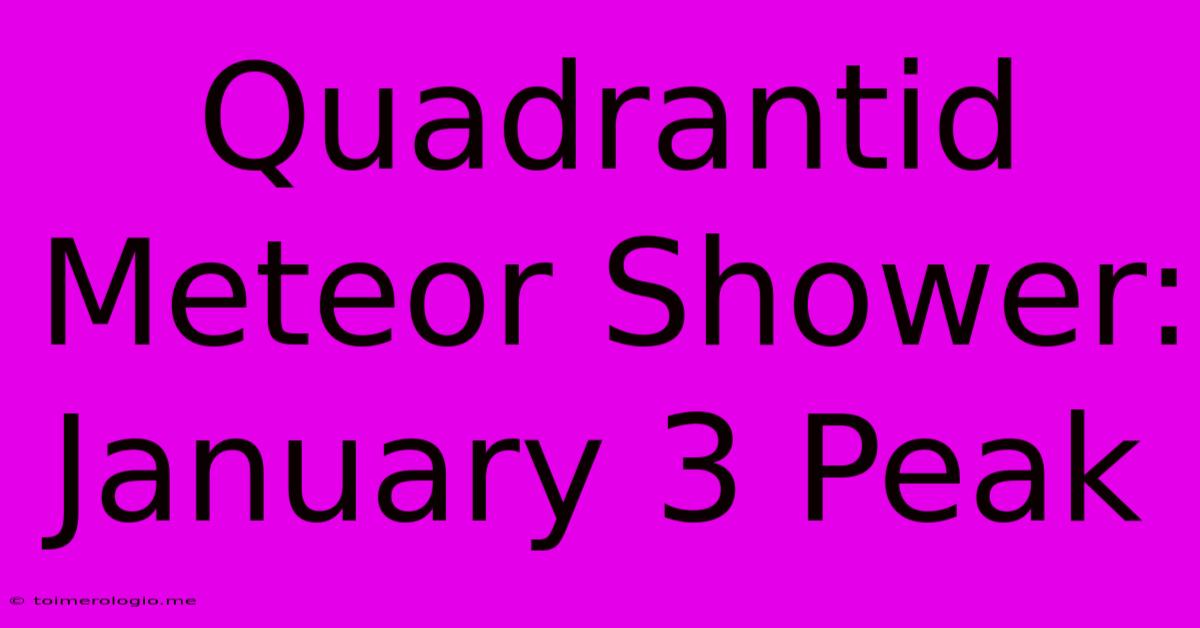Quadrantid Meteor Shower: January 3 Peak

Discover more detailed and exciting information on our website. Click the link below to start your adventure: Visit Best Website toimerologio.me. Don't miss out!
Table of Contents
Quadrantid Meteor Shower: January 3 Peak – A Celestial Spectacle Not to Miss
The night sky is set to ignite with a dazzling display as the Quadrantid meteor shower reaches its peak on January 3rd. For those willing to brave the cold winter nights, this celestial event promises a spectacular show, potentially offering up to 120 meteors per hour at its zenith. But what makes the Quadrantids so special, and how can you maximize your chances of witnessing this breathtaking phenomenon? Let's delve into the details.
Understanding the Quadrantid Meteor Shower
Unlike many meteor showers linked to easily identifiable comets, the origin of the Quadrantids remains somewhat mysterious. While the shower's radiant (the point in the sky from which the meteors appear to originate) lies in the now-defunct constellation Quadrans Muralis (hence the name), astronomers have traced its source to asteroid 2003 EH1. This asteroid is believed to be the remnant of a broken-up comet, a fascinating piece of the solar system's history.
What Makes the Quadrantids Unique?
The Quadrantids stand out from other meteor showers due to several factors:
- Short Peak: Unlike some showers that last for several nights, the Quadrantids boast an exceptionally narrow peak, lasting only a few hours. This means precise timing is crucial for optimal viewing.
- High Zenithal Hourly Rate (ZHR): With a potential ZHR of up to 120 meteors per hour, the Quadrantids offer a potentially spectacular display surpassing many other annual showers. However, reaching this peak rate depends heavily on ideal viewing conditions and the location of the observer.
- Mysterious Origin: The asteroid origin of the shower contributes to its intrigue, offering a unique perspective into the diverse objects that populate our solar system and their interaction with Earth.
Timing is Everything: Maximizing Your Viewing Experience
To witness the Quadrantids at their best, careful planning is essential. Here's what you need to know:
Peak Time:
The shower's peak is expected around January 3rd, in the early morning hours before dawn. The exact time will vary slightly depending on your location, so consulting a reliable astronomy resource or meteor shower calendar for your specific area is recommended.
Location, Location, Location:
Finding a dark location away from city lights is paramount. Light pollution significantly reduces the visibility of fainter meteors. Head to rural areas, national parks, or other locations with minimal light interference for the best experience.
Weather Conditions:
Check the weather forecast before venturing out. Cloudy skies will completely obscure the shower, rendering your efforts futile.
Patience and Comfort:
Meteor showers require patience. It may take some time for your eyes to adjust to the darkness, and meteors won't appear at a constant rate. Dress warmly in layers, as winter nights can be extremely cold. Bring a comfortable chair or blanket to make your viewing experience more enjoyable.
Observing the Quadrantids: Tips and Techniques
- Look Northeast: Locate the constellation Boötes, near the Big Dipper. The radiant of the Quadrantids lies within this area. While meteors can appear anywhere in the sky, focusing your gaze on this region will increase your chances of seeing more.
- Give Your Eyes Time to Adjust: Allow at least 20-30 minutes for your eyes to become fully dark-adapted. Avoid looking at bright screens (phones, flashlights) during this time.
- Use a Red Light: If you need a flashlight, use a red-light filter or cover your flashlight with red cellophane. Red light preserves your night vision far better than white light.
- Lie Back and Relax: The best way to observe a meteor shower is to lie down on a blanket or reclining chair and look straight up.
- Take Pictures (Optional): If you're interested in astrophotography, a DSLR camera with a wide-angle lens and a long exposure time can capture stunning images of the shower. Experiment with different settings to find what works best.
Beyond the Visual Spectacle: The Scientific Significance
The Quadrantids, despite their relatively short peak, offer valuable opportunities for scientific research. Astronomers use meteor showers to learn more about:
- Composition of Asteroids and Comets: Studying the meteors helps scientists understand the composition of the parent body, providing insights into the early solar system.
- Earth's Atmosphere: The trajectories and behavior of meteors provide valuable data about the Earth's upper atmosphere.
- Space Debris: Tracking meteor showers contributes to our understanding of space debris and its potential impact on satellites and spacecraft.
Plan Ahead for the 2024 Quadrantid Meteor Shower!
The 2024 Quadrantid meteor shower offers a fantastic opportunity to connect with the wonders of the universe. By following these tips and planning your observation carefully, you can significantly increase your chances of experiencing this breathtaking celestial event. So, mark your calendars, bundle up, and prepare for a mesmerizing display of shooting stars! Remember to check local astronomy clubs and resources for more precise timing and location-specific advice to maximize your viewing experience. Don't miss this incredible celestial spectacle! The Quadrantids won't disappoint!

Thank you for visiting our website wich cover about Quadrantid Meteor Shower: January 3 Peak. We hope the information provided has been useful to you. Feel free to contact us if you have any questions or need further assistance. See you next time and dont miss to bookmark.
Also read the following articles
| Article Title | Date |
|---|---|
| Globes Hosting Nikki Glasers Worries | Jan 05, 2025 |
| College Basketball Illinois Top 25 Ascent | Jan 05, 2025 |
| Kci Airfield Reopens After Ice Storm | Jan 05, 2025 |
| How Nikki Glaser Will Host The Golden Globes | Jan 05, 2025 |
| Nikki Glaser Ready For Golden Globes | Jan 05, 2025 |
